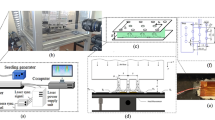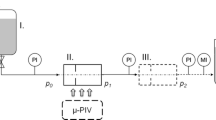Abstract
Turbulent flows in porous media have important practical applications such as enhanced mixing of fuel and air, food drying, and cooling of electronics. However, experimental studies of turbulence in porous media are sparse due to the difficulties of measuring the complex flow environment. To this end, the interactions of steady jets with a porous medium formed from several parallel, transparent, permeable screens are studied using digital particle image velocimetry in a refractive indexed-matched environment. The permeable screens had porosities (open area ratios, ϕ) of 83.8, 69.0, 55.7, and 49.5 % and were held by a transparent frame that allowed the screen spacing to be changed. The steady jet results for Reynolds number (Re), which is defined based on the jet exit velocity and jet diameter, of 1000 showed laminar, predominantly steady flow that was segregated inside the porous medium, but for Re ≥ 2000, the flow was unsteady and turbulent with a mean velocity field that was relatively smooth inside the porous medium. As a result, more traditional jet features of self-similarity and increasing jet width were compared for the Re ≥ 2000 results. Decreasing the porosity was observed to increase the width of the jet significantly, especially for low porosity screens, and slowed the jet flow speed. Some of the typical features for axisymmetric jets were observed, even though the flow impinged on the permeable screens. In particular, self-similarity (or near self-similar behavior) was observed for the cross-sectional mean velocity profiles and for turbulence quantities for porosities larger than 55.7 % inside the porous medium. The effect of ϕ on turbulence quantities was significant for Re ≥ 2000. Although turbulence intensity increased on the downstream side of the first screen, the high dissipation forced drastic decrease of turbulence levels further downstream in the porous domain. Finally, the screens increased the removal of momentum from the jet as porosity decreased and screen spacing had a significant effect on the removal rate.



















Similar content being viewed by others
References
Cant R, Castro I, Walklate P (2002) Plane jets impinging on porous walls. Exp Fluids 32:16–26
Capp SP (1983) ‘Experimental Investigation of the Turbulent Axisymmetric Jet’, PhD Dissertation. Dept Mech and Aero Engineering, University of Buffalo, SUNNY
Crow S, Champagne F (1971) Orderly structure in jet turbulence. J Fluid Mech 48:547–591
Fu WS, Huang H-C (1997) Thermal performance of different shape porous blocks under an impinging jet. Int J Heat Mass Transf 40(10):2261–2272
George WK (1990) Governing equations, experiments and the experimentalist. Exp Therm Fluid Sci 3:557–566
Graminho DR, Lemos MJ (2009) Simulation of turbulent impinging jet into a cylindrical chamber with and without a porous layer at the bottom. Int J Heat Mass Transf 52(3):680–693
Hussein HJ, Capp SP, George WK (1994) Velocity measurements in a high-Reynolds-number, momentum-conserving, axisymmetric, turbulent jet. J Fluid Mech 258:31–75
Jeng T-M, Tzeng S-C (2005) Numerical study of confined slot jet impinging on porous metallic foam heat sink. Int J Heat Mass Transf 48(23):4685–4694
Jugjai S, Wongpanit N, Laokethan T, Nokkaew S (2002) The combustion of liquid fuels using a porous medium. Exp Therm Fluid Sci 26(1):15–23
Kudra T, Mujumdar AS (2009) Advanced drying technologies. CRC Press, Taylor & Francis Group, US
Kwon S, Seo IW (2005) Reynolds number effects on the behavior of a non-buoyant round jet. Exp Fluids 38:801–812
Moreira RG (2001) Impingement drying of foods using hot air and superheated steam. J Food Eng 49:291–295
Musta MN (2012) Interaction of steady jets and vortex rings with an array of multible permeable screens Ph.D. Thesis, Southern Methodist University
Musta MN, Krueger PS (2014) Interaction of vortex rings with multiple permeable secreens. Phys Fluids 26:113101
Pedocchi F, Martin JE, Garcia MH (2008) Inexpensive fluorescent particles for large-scale experiments using particle image velocimetry. Exp Fluids 45:183–386
Prakash M, Turan OF, Li Y, Mahoney J, Thorpea GR (2001a) Impinging round jet studies in a cylindrical enclosure with and without a porous layer: part I: flow visualizations and simulations. Chem Eng Sci 56:3855–3878
Prakash M, Turan OF, Li Y, Mahoney J, Thorpea GR (2001b) Impinging round jet studies in a cylindrical enclosure with and without a porous layer: part II: LDV measurements and simulations. Chem Eng Sci 56:3879–3892
Shahangian N, Ghojel J (2010) Investigation of the interaction between diesel spray and porous medium. In: 17th Australasian fluid mechanics conference. Australasian Fluid Mechanics Conference, Auckland, New Zealand
Todde V, Spazzini PG, Sandberg M (2009) Experimental analysis of low Reynolds number free jets evolution along the jet centerline and Reynolds number effects. Exp Fluids 47:279–294
Uzol O, Chow YC, Katz J, Meneveau C (2002) Unobstructed particle image velocimetry measurements within an axial turbo-pump using liquid and blades with matched refractive indices. Exp Fluids 33:909–919
Webb S, Castro IP (2006) Axisymmetric jets impinging on porous walls. Exp Fluids 40:951–961
Westerweel J, Dabiri D, Gharib M (1997) The effect of a discrete window offset on the accuracy of cross-correlation analysis of digital PIV recordings. Exp Fluids 23:20–28
Willert CE, Gharib M (1991) Digital particle image velocimetry. Exp Fluids 10:181–193
Wilson BM, Smith BL (2013) Uncertainty on PIV mean and fluctuating velocity due to bias and random errors. Meas Sci Technol 24:035302
Acknowledgments
This material is based upon work supported by the National Science Foundation under Grant No. 0652046.
Author information
Authors and Affiliations
Corresponding author
Rights and permissions
About this article
Cite this article
Musta, M.N., Krueger, P.S. Interaction of steady jets with an array of permeable screens. Exp Fluids 56, 61 (2015). https://doi.org/10.1007/s00348-015-1925-7
Received:
Revised:
Accepted:
Published:
DOI: https://doi.org/10.1007/s00348-015-1925-7




